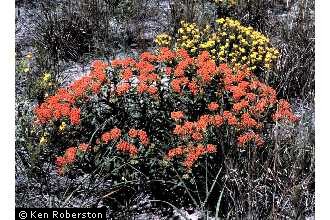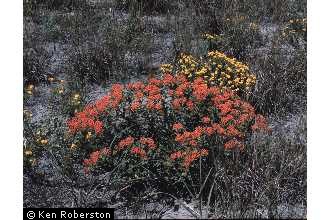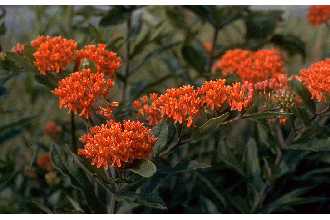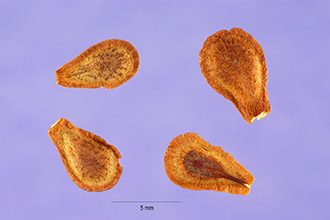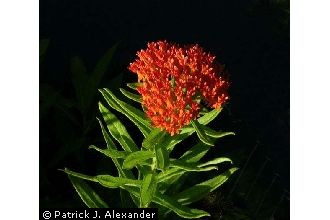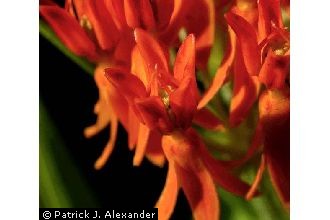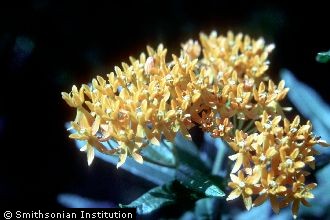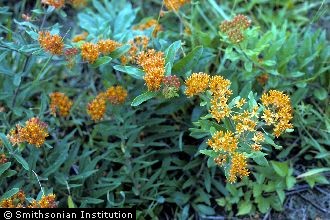Butterfly Milkweed
Scientific Name: Asclepias tuberosa L.
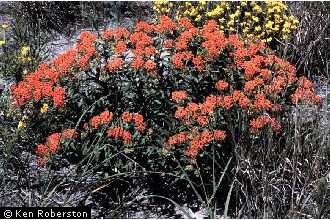
| General Information | |
|---|---|
| Usda Symbol | ASTU |
| Group | Dicot |
| Life Cycle | Perennial |
| Growth Habits | Forb/herb |
| Native Locations | ASTU |
Plant Guide
Alternative Names
orange milkweed, chigger weed
Use
Warning: Milkweed may be toxic when taken internally, without sufficient preparation. Ethnobotanic: Milkweed has been used for fiber, food, and medicine by people all over the United States and southern Canada. Fibers from the stems of milkweed have been identified in prehistoric textiles in the Pueblo region. Tewa-speaking people of the Rio Grande still make string and rope from these fibers. At the Zuni Pueblo, the silky seed fibers are spun on a hand-held wooden spindle and made into yarn and woven into fabric, especially for dancers. Pueblo people ate green milkweed pods and uncooked roots from one of the species that forms fleshy tubers underground. Milkweeds supply tough fibers for making cords and ropes, and for weaving a coarse cloth. Milkweed stems are collected after the stalks senesce in late fall to early winter. The dried stalks are split open to release the fibers. Milkweed fibers are sometimes mixed with fibers of Indian-hemp (Apocynum cannabinum). The bark is removed and the fibers released by first rubbing between the hands and then drawing the fibers over a hard surface. The cord is formed by twisting the fiber opposite each other and twining them together. Often this is accomplished by rolling the fibers on the thigh, while twisting them together. The young shoots, stems, flower buds, immature fruits, and roots of butterfly milkweed were boiled and eaten as a vegetable by various indigenous groups of eastern and mid-western America. © Kenneth Robertson Illinois Dept. of Natural Resources 1999 Butterfly milkweed has many medicinal uses. The Omahas and Poncas ate the raw root of the butterfly milkweed for bronchial and pulmonary troubles. Butterfly milkweed root was also chewed and placed on wounds, or dried, pulverized, and blown into wounds. The Omaha tribe used butterfly milkweed medicine for rites belonging to the Shell Society. The Dakotas used the butterfly milkweed as an emetic. The Menominis considered the butterfly milkweed, which they called the "deceiver," one of their most important medicines. Generalized medicinal uses for milkweed species include 1) its use in a salve for scrofulous swelling, 2) as a diarrhea medicine, 3) drunk by mothers unable to produce milk, 4) medicine for snow blindness and other forms of blindness, 5) relief of sore throat, 6) applied chewed root for swelling and rashes, 7) to expel tapeworm, 8) to treat colic, 9) to act as contraceptives, and 10) to cure snakebite. European Americans used Asclepias tuberosa, called "pleurisy root", to relieve inflammation of the lining of the lungs and thorax, and to relieve bronchial and pulmonary trouble. Pleurisy root is a stimulant to the vagus nerve, producing perspiration, expectoration, and bronchial dilation. As its name signifies, it is useful for pleurisy and mild pulmonary edema, increasing fluid circulation, cilia function, and lymphatic drainage. The root of the butterfly milkweed, was officially listed in the U.S. Pharmacopoeia from 1820 to 1905 and in the National Formulary from 1916 to 1936. Milkweed species, as a group, are known to contain cardiac glycosides that are poisonous both to humans and to livestock, as well as other substances that may account for their medicinal effect. Resinoids, glycosides, and a small amount of alkaloids are present in all parts of the plant. Symptoms of poisoning by the cardiac glycosides include dullness, weakness, bloating, inability to stand or walk, high body temperature, rapid and weak pulse, difficulty breathing, dilated pupils, spasms, and coma. The cardiac glycoside in milkweed has also been useful as a chemical defense for monarch butterflies (Danaus plexippus). Chemicals from the milkweed plant make the monarch caterpillar's flesh distasteful to most predators. Monarch butterflies are specific to milkweed plants. This is the only type of plant on which the eggs are laid and the larvae will feed and mature into a chrysalis. Eggs are laid on the underside of young healthy leaves. Monarch, Queen, and Viceroy butterflies are Müllerian mimics, all are toxic, and have co-evolved similar warning patterns to avoid predation. Wildlife: Milkweed species are attractive to many insect species, including the large milkweed bug, common milkweed bug, red milkweed beetle, blue milkweed beetle, and bees. Accordingly, this is a wonderful horticultural plant for landscaping to attract butterflies (particularly monarchs), whose numbers are declining and migratory routes changing due to lack of appropriate habitat. Butterfly milkweed also has strikingly beautiful flowers. Caution: At one time, milkweed was classified as a noxious weed due to reported toxic effects on livestock, and efforts were made to eradicate it. Milkweeds are thought to be poisonous to cows and sheep. Milkweed also can have invasive characteristics in disturbed areas.
Status
Please consult the PLANTS Web site and your State Department of Natural Resources for this plant’s current status, such as, state noxious status, and wetland indicator values, , Use soil moisture sensors to measure the soil moisture of Butterfly Milkweed.
Description
General: Milkweed Family (Asclepiadaceae). Asclepias tuberosa is a perennial herb 3-9 dm tall with woody rootstocks. According to Kelly Kindscher (1992), "Asclepias comes from the name of the Greek god of medicine, Asklepios. The species name, tuberosa, means full of swellings or knobs, referring to the enlarged root system." Butterfly milkweed stems are hairy, erect, and grow in numerous clumps. There is a watery sap within the stems and leaves. The leaves are alternate, simple, crowded, lance-shaped, 5-10 cm long, shiny green, smooth above and velvety beneath. The flowers are in showy, rounded to flat-topped groups near the ends of branches. Each flower has 5 petals, bent downward, orange to red or sometimes yellow, topped by a crown of 5 erect hoods, each one containing a short horn. Fruits are hairy, spindle-shaped pods 8-15 cm long. The numerous seeds each have a tuft of long white hairs at the tip.
Distribution
Milkweeds grow in clumps beside roadways, on abandoned farmlands, and in other open areas throughout the United States. Butterfly milkweed grows on sandy, loamy, or rocky limestone soils of prairies, open woodlands, roadsides, and disturbed areas similar to other milkweed species. For current distribution, please consult the Plant Profile page for this species on the PLANTS Web site.
Establishment
Butterfly milkweed is easily propagated by both seed and rhizome cuttings. Both seedlings and cuttings will usually bloom in their second year, although cuttings will occasionally bloom during their first year. Seeds and plants of selected cultivars are available from many nurseries. When the roots of the butterfly milkweed were more commonly harvested for their medicinal use, the plants were dug when dormant in the late fall. Butterfly milkweed increases by underground shoots and can be invasive. It is ideal in semi-dry places where it can spread without presenting problems for other ornamental species.
Seed Collections
Asclepias tuberosa is easily propagated from seed. Collect seeds after the pods have ripened, but before they have split open. The seeds are wind dispersed, so be careful when gathering to place in a paper or burlap bag to avoid losing them. Butterfly milkweed seeds should be cold-treated for three months. Seeds can be directly sewn into the ground in the fall. The seed is very viable. It is not certain how long you can store the seeds.
Whole Plant Collections
Propagation by cuttings of the tuberous rhizome is also easy and reliable. The cuttings should be made when the plant is dormant. Each piece of the rhizome should have at least one bud (they are about two inches apart). Timing of propagation is important. Harvest or divide plants and get the plants in the ground by late fall so they can develop enough root growth to survive the winter. Irrigation the first year will improve survival, and by the second year the root system should be well enough established so plants will survive on their own. Both seedlings and cuttings will usually bloom in their second year, although cuttings will occasionally bloom during their first year (Kindscher 1992).
Management
Both milkweed and dogbane are burned in the fall to eliminate dead stalks and stimulate new growth. Burning causes new growth to have taller, straighter stems (with longer fibers). It also stimulates flower and seed production. When used for fiber, milkweed is collected in the autumn after the leaves have begun to fall off, the stalks turn gray or tan, and the plant dries up. If the milkweed stems will break off at the ground it's time to harvest. Breaking off as many stalks as possible encourages resprouting in the spring. The dried stalks are then split open and the fibers are twisted into string. Vast quantities of fiber plants are required for nets, regalia, and cordage. Blackburn and Anderson (1993) quote Craig Bates of the Yosemite Museum that it takes approximately five stalks of milkweed or Indian hemp to manufacture one foot of cordage. A Sierra Miwok feather skirt or cape contained about 100 feet of cordage made from approximately 500 plant stalks, while a deer net 40 feet in length (Barrett and Gifford 1933:178) contained some 7,000 feet of cordage, which would have required the harvesting of a staggering 35,000 plant stalks. Cultivars, Improved and Selected Materials (and area of origin) ASTU is readily available through native plant nurseries within its range. Seeds and plants of selected Asclepias cultivars are available from many nurseries. It is best to plant species from your local area, adapted to the specific site conditions where the plants are to be grown.
References
Blackburn, T.C. & M.K. Anderson 1993. Before the wilderness. Environmental management by Native Californians. A Ballena Press Publication. 476 pp. Bouton, D.W. 1995. The monarch butterfly. A fragile tissue in the wind. Continuum Publishers, Harpersville, New York. Dunmire, W.W. & G.D. Tierney 1995. Wild plants of the Pueblo province. Exploring ancient and enduring uses. Museum of Mexico Press, Santa Fe, New Mexico. 289 pp. Dunmire, W.W. & G.D. Tierney 1997. Wild plants and Native Peoples of the Four Corners. Museum of New Mexico Press. 312 pp. Gilmore, M.R. 1977. Uses of plants by the Indians of the Missouri River region. University of Nebraska Press. 125 pp. Grace, E.S. 1997. The world of the monarch butterfly. Sierra Club Books, San Francisco, California. 114 pp. Hedrick, U.P. 1972. Sturtevant's edible plants of the world. Dover Publications, Inc., New York, New York. 686 pp. Illinois Department of Natural Resources 1999. The tallgrass prairie of Illinois. Version: 000328. <http://www.inhs.uiuc.edu/~kenr/prairieplants.html>. Illinois Natural History Survey, Center for Biodiversity, Champaign, Illinois. Kindscher, K. 1992. Medicinal wild plants of the prairie. An ethnobotanical guide. University Press of Kansas. 340 pp. Martin, Alexander C., Herbert S. Zim, & Arnold L. Nelson 1951. American wildlife and plants. A guide to wildlife food habits. Dover Publications, Inc., New York, New York. 500 pp. Powell, J.A. & C.L. Hogue 1979. California insects. University of California Press. 388 pp. Stewart, B. 1997. Common butterflies of California. West Coast Lady Press. 255 pp. University of Kentucky 2000. Wildlflowers of western Kentucky. Version: 000328. <http://sac.uky.edu/~mthom0/ormilkwd.htm>. Lexington, Kentucky. USDA, NRCS 2000. The PLANTS database. Version: 000328. <http://plants.usda.gov>. National Plant Data Center, Baton Rouge, Louisiana.
Plant Traits
Growth Requirements
| Temperature, Minimum (°F) | -33 |
|---|---|
| Adapted to Coarse Textured Soils | Yes |
| Adapted to Fine Textured Soils | No |
| Adapted to Medium Textured Soils | Yes |
| Anaerobic Tolerance | None |
| CaCO3 Tolerance | Medium |
| Cold Stratification Required | No |
| Drought Tolerance | High |
| Fertility Requirement | Low |
| Fire Tolerance | High |
| Frost Free Days, Minimum | 135 |
| Hedge Tolerance | None |
| Moisture Use | Low |
| pH, Maximum | 6.8 |
| pH, Minimum | 4.8 |
| Planting Density per Acre, Maxim | 7200 |
| Planting Density per Acre, Minim | 3450 |
| Precipitation, Maximum | 45 |
| Precipitation, Minimum | 28 |
| Root Depth, Minimum (inches) | 16 |
| Salinity Tolerance | None |
| Shade Tolerance | Intolerant |
Morphology/Physiology
| After Harvest Regrowth Rate | Slow |
|---|---|
| Toxicity | None |
| Resprout Ability | No |
| Shape and Orientation | Erect |
| Active Growth Period | Spring and Summer |
| Bloat | None |
| C:N Ratio | Low |
| Coppice Potential | No |
| Fall Conspicuous | No |
| Fire Resistant | No |
| Flower Color | Orange |
| Flower Conspicuous | Yes |
| Foliage Color | Green |
| Foliage Porosity Summer | Moderate |
| Foliage Porosity Winter | Porous |
| Fruit/Seed Color | Brown |
| Nitrogen Fixation | None |
| Low Growing Grass | No |
| Lifespan | Moderate |
| Leaf Retention | No |
| Known Allelopath | No |
| Height, Mature (feet) | 2.0 |
| Growth Rate | Slow |
| Growth Form | Multiple Stem |
| Fruit/Seed Conspicuous | Yes |
| Foliage Texture | Coarse |
Reproduction
| Vegetative Spread Rate | None |
|---|---|
| Small Grain | No |
| Seedling Vigor | Low |
| Seed Spread Rate | Slow |
| Fruit/Seed Period End | Fall |
| Seed per Pound | 70000 |
| Propagated by Tubers | No |
| Propagated by Sprigs | No |
| Propagated by Sod | No |
| Propagated by Seed | Yes |
| Propagated by Corm | No |
| Propagated by Container | Yes |
| Propagated by Bulb | No |
| Propagated by Bare Root | No |
| Fruit/Seed Persistence | No |
| Fruit/Seed Period Begin | Summer |
| Fruit/Seed Abundance | Medium |
| Commercial Availability | Routinely Available |
| Bloom Period | Mid Summer |
| Propagated by Cuttings | No |
Suitability/Use
| Veneer Product | No |
|---|---|
| Pulpwood Product | No |
| Protein Potential | Low |
| Post Product | No |
| Palatable Human | No |
| Palatable Graze Animal | Low |
| Palatable Browse Animal | Low |
| Nursery Stock Product | Yes |
| Naval Store Product | No |
| Lumber Product | No |
| Fodder Product | No |
| Christmas Tree Product | No |
| Berry/Nut/Seed Product | No |

